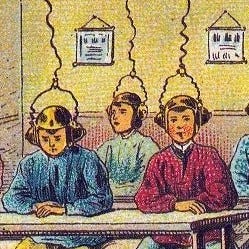There is a bias in stories about the future to feature advanced technology, on the assumption that the stable social systems that have led to a steady stream of life-changing inventions over the last 150 years or so will continue unabated. Even the name “science fiction” suggests scientific progress, unlike a more semantically neutral term like “speculative fiction”1.
The main exception is the brand of science fiction adhering to Dator’s Post-Collapse archetype, though more dystopian variants do often still use some kind of advanced technology as a tool for social control. Post-apocalyptic stories are common in our images of the future for a few reasons, including the rise of doomerism and our desire to imagine swapping the mental/spiritual exhaustion of modern life for something simpler.
It’s much rarer for media (other than action films) to take place in the “end of the world” itself - usually the apocalypse in question is brief enough that a mid-apocalyptic story wouldn’t allow for much of a dramatic arc. There are exceptions but they often collapse to one of the two paradigms above - for example, Interstellar starts as a story of technological stagnation and social regression (particularly the undoing of decades of urbanization) but then shifts to a more conventional science fiction story about near-light-speed space travel.
Parable of the Sower by Octavia Butler imagines a future with almost no new technology playing a role - there is a US manned mission to Mars briefly mentioned, but that’s about it. Rather, it’s the story of a society collapsing in slow motion, not from a single catastrophic event but by degrees: climate change making densely populated areas in coastal areas and the southern United States unlivable, government becoming increasingly dysfunctional and ineffective, and social order breaking down as income inequality and economic displacement continue to grow2. The story examines this world through the diary entries of Lauren Olamina, a teenager growing up in the last precarious vestiges of the middle class in suburban Los Angeles from 2024-2027. Lauren struggles with the unraveling of the foundations of trust that make modern life possible, and the refusal of the adults in her life to understand that the old world isn’t coming back. These struggles are intensified by a medical/psychological condition that leads to her feeling the pain (and, infrequently given the circumstances, the pleasure) of those around her. Lauren comes of age in an amplified version of the way people always have: by leaving her childhood home and striking out in a dangerous world where she has to forge a new family and sense of community3.
At another level of abstraction, the book is about the development of Lauren’s philosophy of Earthseed, a proto-religion based around recognizing change as the most powerful force in the universe and learning to adapt to and shape it. As a corollary, Earthseed sees the creation of human settlements on multiple worlds as the destiny of humanity4 because it’s the best way to become resilient to planetary-scale change, though that’s mostly just a conviction and idle dream for someone as close to the edge of survival as Lauren.
Earthseed serving as a North Star for Lauren is a pretty close analog to the foresight work of creating a preferred future that serves as a guide for planning and action. In addition, there is a fair amount of overlap with the idea I explored in week 5 of a transcendental, transpersonal, secular spirituality posed by Richard Slaughter as necessary for the next stage of human development. Using hope for a better future as a guide for action and as a balm for the weary soul is essentially the emotional/spiritual dimension of the “imagination and agency” conception of foresight I have been using.
The book itself is great and easy to recommend if you can handle its bleakness - tense, spare, clear stakes, etc. It may be too grim and ambiguous to qualify as hopepunk, but definitely too hopeful to be grimdark5. The book isn’t particularly explicit, but it does include a broad range of sensitive subjects (for example, the dog does in fact die). With so many things in our modern world in an obvious state of decay (trust in institutions, public infrastructure, the internet6, Star Wars), this image of a future without progress is urgent and thought-provoking.
Though in practice, this term is anything but neutral: speculative fiction has been deliberately used as a term of art to write about the future without taking the perceived unserious reputation of science fiction.
For a book published 30 years ago that takes place over the next few years, this is more than a little unnerving.
This archetype goes all the way back to the Garden of Eden and the Fall of Adam and Eve.
This conception of settlement as not only essential to avoid extinction (which is basically Elon Musk’s position), but our divine destiny as sentient Earth-born life, is of course a strong echo of Manifest Destiny and the Doctrine of Discovery that justified centuries of colonization. The moral implications of this distinction are addressed well in Erika Nesvold’s book Off-Earth, which I covered a few weeks ago.
Basically, it does take on the “small light shining in darkness” vibe of The Lord of the Rings, but with characters that are more morally complex.
Quality of search results, increase in garbage content, bad product recommendations, etc.



